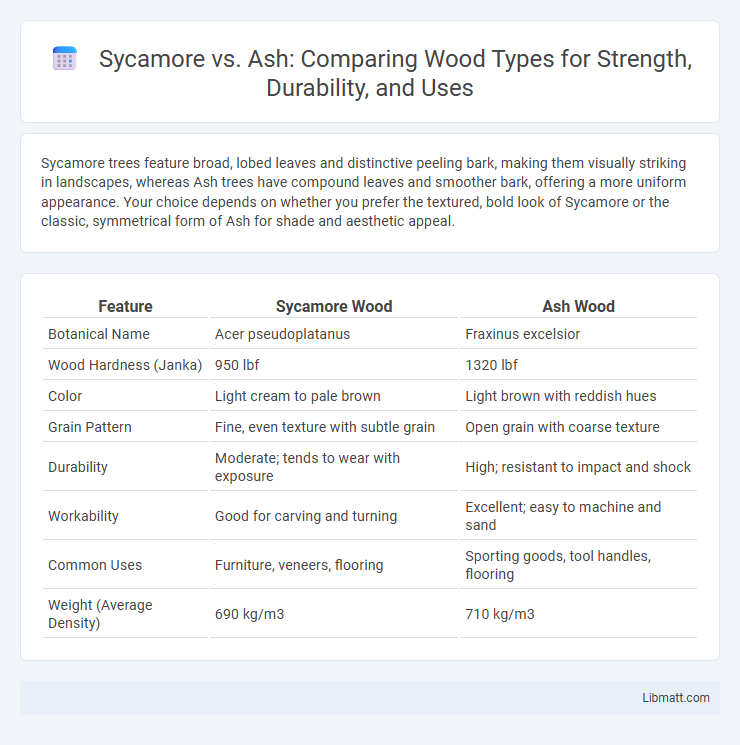Sycamore trees feature broad, lobed leaves and distinctive peeling bark, making them visually striking in landscapes, whereas Ash trees have compound leaves and smoother bark, offering a more uniform appearance. Your choice depends on whether you prefer the textured, bold look of Sycamore or the classic, symmetrical form of Ash for shade and aesthetic appeal.
Table of Comparison
| Feature | Sycamore Wood | Ash Wood |
|---|---|---|
| Botanical Name | Acer pseudoplatanus | Fraxinus excelsior |
| Wood Hardness (Janka) | 950 lbf | 1320 lbf |
| Color | Light cream to pale brown | Light brown with reddish hues |
| Grain Pattern | Fine, even texture with subtle grain | Open grain with coarse texture |
| Durability | Moderate; tends to wear with exposure | High; resistant to impact and shock |
| Workability | Good for carving and turning | Excellent; easy to machine and sand |
| Common Uses | Furniture, veneers, flooring | Sporting goods, tool handles, flooring |
| Weight (Average Density) | 690 kg/m3 | 710 kg/m3 |
Introduction to Sycamore vs Ash
Sycamore and Ash are two popular hardwoods commonly used in furniture making and interior design due to their durability and distinctive grain patterns. Sycamore features a fine, even texture with a pale cream color that can include subtle flecks, while Ash is known for its strong, straight grain and light brown to beige hues. Understanding the unique characteristics of Sycamore vs Ash helps you choose the best wood for your project's aesthetic and functional needs.
Botanical Overview of Sycamore
Sycamore trees, belonging to the genus Platanus, are known for their broad, lobed leaves and distinctive mottled bark that peels off in patches. These deciduous trees thrive in temperate regions and can reach impressive heights, offering extensive shade and robust growth. Your landscape benefits from sycamore's tolerance to urban pollution and diverse soil conditions, making it a versatile choice compared to the typically smaller and more delicate ash species.
Botanical Overview of Ash
Ash trees (genus Fraxinus) are deciduous hardwoods belonging to the Oleaceae family, known for their pinnate leaves and distinctive diamond-patterned bark. They thrive in temperate regions across the Northern Hemisphere, often used in landscaping and woodcraft due to their strength and durability. Your choice between Sycamore and Ash may depend on the Ash's rapid growth, resistance to pests like the Emerald Ash Borer, and ecological value in supporting wildlife.
Identification: Sycamore vs Ash Leaves
Sycamore leaves are large, broad, and maple-like with three to five lobes and serrated edges, often featuring a palmate vein pattern. Ash leaves, by contrast, are compound with multiple narrow leaflets arranged oppositely along a central stem, each leaflet typically having smooth or slightly serrated margins. When identifying trees, observing your leaves for these distinct characteristics helps accurately distinguish between Sycamore and Ash.
Wood Characteristics: Sycamore vs Ash
Sycamore wood features a fine, even texture with a pale cream to light brown color, offering moderate hardness and excellent workability for furniture and flooring. Ash wood is known for its distinct grain, light color with occasional darker streaks, and superior strength and flexibility, making it ideal for sports equipment and tool handles. Your choice depends on whether you prioritize Sycamore's smooth finish and stability or Ash's durability and resilience.
Uses and Applications of Sycamore Wood
Sycamore wood is highly valued for its fine, even texture and exceptional hardness, making it ideal for furniture production, cabinetry, and flooring. Its resistance to splitting and smooth finish contribute to its extensive use in musical instruments and butcher blocks. Compared to ash, sycamore's aesthetic appeal and workability make it a popular choice in decorative veneers and high-quality woodturning projects.
Uses and Applications of Ash Wood
Ash wood is prized for its exceptional strength, flexibility, and shock resistance, making it a preferred material for sports equipment such as baseball bats and tool handles. Its straight grain and light color also suit high-quality furniture, flooring, and cabinetry applications, providing durability and aesthetic appeal. In addition, ash wood's workability makes it ideal for musical instruments and architectural millwork, where precision and resilience are critical.
Growth Habits and Distribution
Sycamore trees (Platanus genus) exhibit rapid growth with broad, spreading canopies and are commonly found across North America, Europe, and parts of Asia, thriving in moist, riparian environments. Ash trees (Fraxinus genus) generally grow at a moderate rate with an upright, oval crown, favoring well-drained soils in temperate regions across Europe, Asia, and North America. Both species play important ecological roles but differ significantly in their growth patterns and habitat preferences.
Disease Resistance and Longevity
Sycamore trees exhibit strong resistance to common diseases such as anthracnose, contributing to their longevity of up to 200 years in favorable conditions. Ash trees, however, are highly susceptible to emerald ash borer infestations, significantly reducing their lifespan, often to less than 50 years if untreated. The robust disease resistance of Sycamore enhances its durability in urban and natural landscapes compared to the comparatively vulnerable Ash species.
Choosing Between Sycamore and Ash
Choosing between sycamore and ash depends on your specific needs for durability and aesthetics; sycamore offers a lighter, more uniform grain ideal for fine furniture and interior paneling, while ash provides strength and flexibility favored in tool handles and sports equipment. Both hardwoods excel in workability but differ in color and texture, with sycamore exhibiting a pale, creamy tone and ash displaying a more pronounced grain with golden hues. Assess your project requirements to determine whether sycamore's smooth finish or ash's robustness aligns best with your goals.
Sycamore vs Ash Infographic

 libmatt.com
libmatt.com